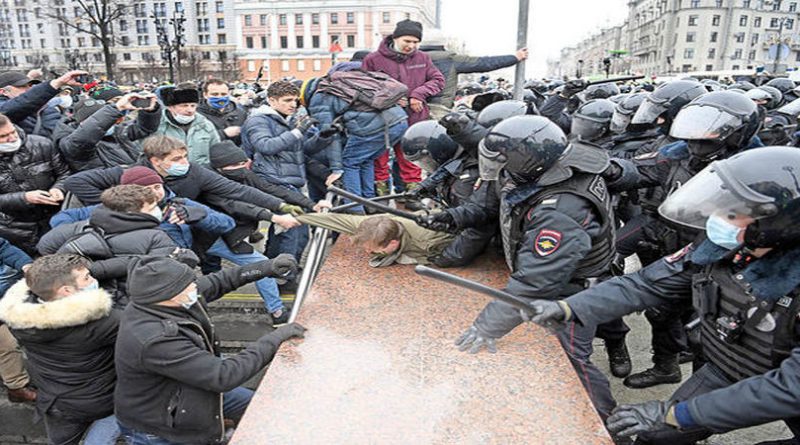Russia from Siberia to Moscow; The scene of the demonstration against Putin
From sub-zero and icy areas of eastern Russia and Siberia to the grand palaces of Moscow and St. Petersburg, tens of thousands of Russians took to the streets in support of imprisoned opposition leader Alexei Navalny.
The protests on Saturday, February 25, were the largest demonstrations in recent years and the largest maneuver of power between the Kremlin and the opposition. These demonstrations are not, of course, a major threat to Vladimir Putin’s seizure of power, but the wide range of these demonstrations and the remarkable protests of the protesters, which were clearly demonstrated in the streets, show the widespread and extreme tiredness of stagnation, corruption and the ruling regime. Putin has been riding it for four decades and imposing it on his society. The demonstrations broke out in eastern Russia, which has 11 time zones, the Anton Troyanovsky and Andrew Higgins wrote in a Jan. 23 report to the New York Times. The protesting crowd continued to move like a “flood” despite the significant presence of police in all parts of the country. Protesters apparently warned the state media to stay away from the incident.
On Sakhalin Island, hundreds of people gathered in front of local government buildings, chanting “Putin is a thief.” Demonstrations also spread to the sub-Arctic city of Yukotsk. The temperature in this region is 60 degrees below zero and the population was in the ranks of thousands in Siberian cities. Hours later, as the curtain fell on Moscow, people clashed with police in snowballs and overturned an intelligence vehicle. As of Saturday evening, more than 3,000 people had been arrested in 109 cities, according to OVD-Info, an activist group monitoring the protests. Earlier, police had warned protesters to deal with. Even schools and universities had warned students to take to the streets in protest (The World Economy had previously reported in two reports entitled “The spark for the first anti-government protests in Russia” on February 26, 1999 and “Alexi’s nightmare at Putin’s palace”). This was mentioned on January 20, 1999).
“Trojanovsky-Higgins” also wrote: “It seems that the distinguishing feature of these demonstrations from previous demonstrations is the significant presence of the younger generation in them.” They want a free and democratic Russia and an end to violent repression. Other protesters chanted “Freedom for Navalny” and “Putin, get lost.” The wave of protests, which continues from east to west Russia, has a common slogan: “Putin is a thief.” The protests go back to a video that was posted on Navalny’s website as soon as he returned to his country when he was arrested at the airport. In this film, he unveiled a luxurious palace that, according to him, belongs to Putin. This has led many young people to take to the streets chanting “Putin is a thief.” Navalny supporters claim the protests are a success. They have promised more demonstrations in the coming weeks.
In Moscow on Saturday evening, large numbers of protesters gathered in front of the detention center where Alexei Navalny is being held, leading to a large number of arrests. Alexia Navalny’s wife Yulia and her colleague Lyubol Sobol were arrested for the first time during a protest in Moscow. However, Navalny’s wife was released a few hours later. This time, Putin is directly involved in the protests; Because he and his power apparatus are accused of corruption. Navalny has been exposing the entanglements within Putin’s apparatus for years, and for that reason has many enemies within the Russian leadership. Navalny and his team have for the first time released images and eyewitness accounts and documents about the owner of Russia’s largest private fortune in the latest video released, “A Palace for Putin.” In the video, Navalny’s team shows Putin’s billion-dollar palace and “tsarist fortune,” which consists of a large ice hockey hall, a helicopter landing pad, a casino and a water disco built around a Putin-owned palace. have became. A few days have passed since the release of this video with 70 million views. According to sociologists, the release of this video has angered many Russian citizens and taken them, many of them young, to the streets.
“If Putin thinks that the most horrible things are behind him, he is simply wrong,” Leonid Volkov, Navalny’s senior aide, said in a live YouTube message from outside Russia. Alexei Navalny, a staunch critic of the Russian government, was deported to Germany in the late summer of 2020 following a Novichuk gas poisoning. Although the finger of blame was pointed at the Kremlin’s secret forces, the Kremlin denied any wrongdoing. Navalny, who could face up to several years in prison, called on his supporters across the country to take to the streets this week; Authorities opposed the protest with all available police forces, special services and the army. ” New York Times reporters believe that Saturday’s demonstration was the largest nationwide demonstration since 2017. These demonstrations also included many metropolises; Eastern cities such as Yekaterinburg, Novosibirsk, Tomsk, Omsk and Vladivostok in the Pacific. Vyacheslav Ivanets, a lawyer in Irkutsk, Siberia, who took part in the protests, said: “There was a feeling that Russian public opinion was as solid as cement or dead. “But now I feel the situation has changed.”
Navalny has emerged as the only opposition leader capable of mobilizing a wide range of people in different walks of life. His position among Putin’s critics has increased; Because after the severe poisoning that caused him to go into a coma for a while, many speculated that he would not return to the country. But his return earned him the respect, status and popularity of Putin’s critics
